Raw Food Recipes
How Can Animals Eat Raw Food? Insights and Facts
How do animals digest raw food so effectively? Discover the fascinating adaptations that make this possible and what it means for their health.

Animals can eat raw food thanks to their unique digestive systems that have evolved to handle uncooked meat effectively. They possess stronger stomach acids and specialized enzymes, which help break down high-protein diets. Their longer digestive tracts enable fast food transit, preventing spoilage. Carnivorous pets often thrive on raw food, showing improved health, energy, and coats. However, there are risks, like harmful bacteria and nutritional imbalances. Proper hygiene and regular vet consultations are essential to guarantee safety. If you want to discover more about the benefits and challenges of raw diets, you'll find plenty of insights ahead.
Key Takeaways
- Carnivorous animals have evolved specialized digestive systems with stronger stomach acids and enzymes to efficiently break down raw meat.
- Their longer digestive tracts facilitate quick food transit, minimizing spoilage and maximizing nutrient absorption.
- Unique immune systems in carnivores help protect against pathogens present in raw meat, reducing foodborne illness risks.
- Raw diets can provide essential nutrients and align with ancestral eating patterns, promoting overall health in pets.
- However, raw meat consumption carries risks of bacterial contamination and nutritional imbalances, requiring careful management and hygiene practices.
Understanding Animal Digestion
When you think about how animals digest food, it's fascinating to realize that their systems are uniquely designed for their diets. Carnivorous species, in particular, have evolved to thrive on raw meat, thanks to stronger stomach acids and specialized digestive enzymes. These adaptations allow them to effectively break down and digest high-protein diets, extracting essential nutrients efficiently.
For example, many animals, like birds, have specific behaviors and dietary needs that influence their digestion and health, such as the importance of avoiding toxic foods understanding bird behavior.
Their longer digestive tracts facilitate quicker food transit, which is vital for consuming prey before it spoils. Unlike humans, carnivores possess immune systems specifically adapted to handle the pathogens found in raw meat. This provides them with a natural defense against foodborne illnesses, making it safer for them to eat their natural diet.
Additionally, the shorter food chains in their habitats reduce the risk of bacterial growth on their prey, allowing them to consume raw food with less concern. This combination of robust stomach acids, effective digestive enzymes, and specialized immune systems is what enables these animals to thrive on diets that would pose risks to others.
Understanding these factors highlights the incredible adaptations that allow carnivorous animals to consume and digest raw food safely.
Evolution of Carnivorous Diets

The evolution of carnivorous diets showcases the remarkable adaptability of various species to thrive on raw food sources. Carnivorous animals have developed significant adaptations that enable them to efficiently consume and digest raw meat-based diets. For instance, they possess stronger stomach acids and specialized digestive enzymes that break down meat effectively while killing harmful pathogens present in their food.
The importance of selecting the right cold medications for effective relief is akin to how these animals choose their food sources to maximize nutrient absorption.
Additionally, the digestive systems of many carnivorous species feature longer intestines, allowing for quick food transit. This design reduces the time bacteria have to proliferate, minimizing the risk of illness. Furthermore, evolution has equipped these animals with robust immune systems, enabling them to withstand the pathogens that might linger in their diets.
Unlike humans, carnivorous animals have evolved unique adaptations that help them thrive on raw diets. Their shorter food chains in the wild further minimize bacterial contamination, making raw meat a safer option for them.
The evolutionary adaptations of these species illustrate their dependence on raw meat as a primary food source. Understanding these differences highlights the distinct dietary needs that separate carnivorous animals from omnivorous species, including humans.
Risks of Raw Meat Consumption

When you consider feeding your pet raw meat, it's vital to understand the health risks involved.
Raw meat can harbor harmful bacteria like E. coli and Salmonella, which can lead to serious illnesses.
Moreover, it's important to evaluate the potential for financial considerations for elderly care if your pet becomes sick due to improper diet.
Additionally, there's a potential for nutritional deficiencies if the diet isn't properly balanced.
Health Risks Overview
Many pet owners may not realize the health risks associated with feeding their animals raw meat. The consumption of raw meat can lead to significant health complications due to potential contamination with harmful bacteria like Salmonella, E. coli, and Campylobacter.
Breast cancer symptoms can also arise from improper handling of raw foods, as pets can carry pathogens that affect human health. Studies show that nearly 80% of raw chicken diets tested positive for Salmonella, highlighting the prevalence of bacterial contamination.
When pets consume raw diets, they might shed these pathogens in their feces for up to two weeks, posing a risk to human health, especially in households with young children or immunocompromised individuals.
Long-term consumption of raw meat can exacerbate the risk of foodborne illness, particularly when proper food handling and hygiene practices aren't followed.
It's important to remember that pets lack innate immunity against pathogens in raw meat, meaning they can suffer serious health issues from unprocessed animal products.
While you might think raw diets provide health benefits, the potential for contamination and the associated health risks can't be overlooked. Always consider these factors when planning your pet's diet.
Bacterial Contamination Concerns
Feeding pets raw meat carries significant risks due to potential bacterial contamination, which can affect both animals and humans. Financial mistakes to avoid can also extend to pet care choices, as the costs associated with treating illnesses from raw meat consumption can add up quickly.
Raw meat can harbor harmful bacteria like Salmonella, E. coli, and Campylobacter, posing serious health risks. A study revealed that nearly 80% of raw chicken diets for pets tested positive for Salmonella, highlighting the prevalence of these dangers. If your dog consumes raw diets, they might shed Salmonella in their feces for up to two weeks, increasing the risk of transmission to you and other pets.
It's vital to maintain proper hygiene practices to mitigate these risks. This includes thoroughly cleaning feeding bowls and preparation areas after each use.
If you have young children or immunocompromised individuals in your household, you need to exercise extra caution, as they're particularly vulnerable to Salmonella exposure from pets fed raw diets.
While some pet owners advocate for raw feeding, it's important to weigh the benefits against the potential health risks associated with bacterial contamination. Always prioritize the safety of everyone in your home when considering raw meat for your pets.
Nutritional Deficiencies Potential
Raw meat diets can pose serious nutritional deficiencies for pets, raising concerns among pet owners. Many homemade raw diets fall short in providing essential nutrients necessary for your pet's health. About 70% of these diets are unbalanced, leading to significant health risks.
Proper nutrition is fundamental for overall wellbeing and development, especially in pets that may experience growth stages similar to key domains of development in humans.
Consider these potential issues with raw diets:
- Calcium and Phosphorus Imbalances: Nutritional osteodystrophy can arise from improper mineral ratios.
- Hypervitaminosis A: Excessive liver intake may result in toxic vitamin A levels.
- Obesity Risks: High fat content in some raw meat diets may contribute to obesity over time.
- Deficiencies in Essential Nutrients: Lacking potassium, magnesium, and certain vitamins can compromise overall pet health.
- Nutritional Quality Concerns: Many raw diets fail to meet the nutritional quality required for peak pet health.
As a responsible pet owner, it's important to guarantee your pet gets all essential nutrients.
Raw diets can be risky if they aren't carefully formulated. Always consult with a veterinarian before making significant dietary changes to safeguard your pet's health.
Nutritional Benefits of Raw Food

A raw food diet can offer numerous nutritional benefits for animals, providing essential nutrients that support their health. These diets are rich in important components like Vitamin C, B12, and heme iron, which are readily bioavailable, often lacking in plant-based foods.
Additionally, raw diets can be rich in antioxidants, which are beneficial for overall health, similar to the benefits seen in cranberry juice consumption. Raw organs stand out as particularly nutrient-dense, delivering a complete profile of vitamins and minerals essential for your pet's well-being.
One significant advantage of raw food is the reduced fiber content found in raw meat, which can facilitate easier digestion. This leads to more efficient nutrient absorption, allowing your pet to make the most of their food. Many pet owners report improvements in their animals' skin and coat condition, higher energy levels, and better overall health when switching to raw diets.
Moreover, these raw food options may align more closely with the ancestral dietary patterns of carnivorous pets. This alignment can potentially enhance their natural health and vigor, reflecting the benefits of consuming a diet that mimics what their ancestors thrived on.
Cultural Practices Surrounding Raw Diets

When you explore raw diets across cultures, you'll find a rich tapestry of traditional dishes like sushi and steak tartare that highlight regional tastes.
These dishes reflect not just culinary preferences but also deep-rooted cultural attitudes toward raw food. For instance, the acceptance of raw fish in Japanese cuisine can be linked to cultural practices surrounding freshness and quality, similar to how BPD dynamics in relationships affect interpersonal connections.
Understanding these variations can give you insight into how different communities embrace raw consumption as part of their heritage.
Traditional Raw Food Dishes
Exploring traditional raw food dishes reveals a fascinating tapestry of cultural practices that celebrate the consumption of uncooked ingredients.
Across different cultures, raw food not only reflects local resources but also showcases culinary artistry. In many ways, these culinary practices parallel the unique experiences offered on luxury cruises, where local flavors and traditions are embraced, enhancing the overall experience for travelers authentic art auctions onboard.
Here are some traditional raw dishes you might find intriguing:
- Sushi and Sashimi: Japanese dishes that highlight the freshness of raw fish and seafood.
- Steak Tartare: A French dish featuring finely chopped raw beef, often enhanced with various seasonings.
- Mett: A popular raw pork dish in Germany and Poland, representing regional culinary preferences.
- Inuit and Sami Practices: Cultures that incorporate raw whale, fish, and reindeer meat, utilizing what their environments provide.
- Maasai Tradition: The East African community known for drinking raw cow's blood, emphasizing nutritional practices.
These dishes not only reveal the diverse ways cultures embrace raw food but also illustrate the significance of quality and tradition in diets worldwide.
Cultural Attitudes Toward Raw
Cultural attitudes toward raw diets vary greatly across the globe, with many societies embracing the consumption of uncooked foods as a crucial part of their culinary identity. For instance, in Japan, sushi and sashimi highlight the traditional consumption of raw fish, while France's steak tartare showcases raw meat in a gourmet context.
Indigenous groups, like the Inuit and Sami, have relied on raw whale and reindeer meat as staples, demonstrating how raw diets can be significant for survival in harsh environments. In addition, some cultures believe that consuming raw foods may offer health benefits, such as enhanced nutrient retention, similar to the way certain crucial oils, like eucalyptus and peppermint, can support overall well-being crucial oils for respiratory health.
Moreover, the Maasai people of East Africa consume raw cow's blood, integrating it into their diet in culturally significant ways. These practices stem from cultural beliefs that emphasize the health benefits of raw diets, with many advocating that uncooked foods retain more nutrients than processed alternatives.
However, these views often clash with modern food safety concerns, sparking debates within communities about the risks associated with consuming raw meat. As you explore these cultural practices, it's crucial to understand the balance between tradition and the increasing emphasis on food safety in today's world.
Regional Variations in Consumption
Raw food consumption varies markedly across regions, reflecting unique culinary practices and cultural beliefs. Each culture showcases its appreciation for the nutritional benefits of raw diets, influenced by local ingredients and traditional methods of preparation.
Here are some notable examples:
- Japan: Sushi and sashimi highlight a reverence for fresh seafood, emphasizing quality and flavor.
- France and Italy: Steak tartare and carpaccio reveal a sophisticated approach to raw beef, often enhanced with seasonings to elevate taste.
- Germany and Poland: Dishes like Mett, consisting of raw minced pork, illustrate local customs surrounding raw meat consumption that are deeply rooted in tradition.
- Inuit and Sami cultures: They consume raw whale, fish, and reindeer meat, using traditional methods to guarantee safety and maximize nutritional value.
- Maasai people of East Africa: Drinking raw cow's blood provides crucial nutrition and signifies cultural practices tied to their pastoral lifestyle.
These regional variations in consumption not only nourish but also reflect a profound cultural appreciation for the diverse ways humans engage with raw food diets.
Understanding these practices deepens our insight into food's role in different societies.
Misconceptions About Raw Meat
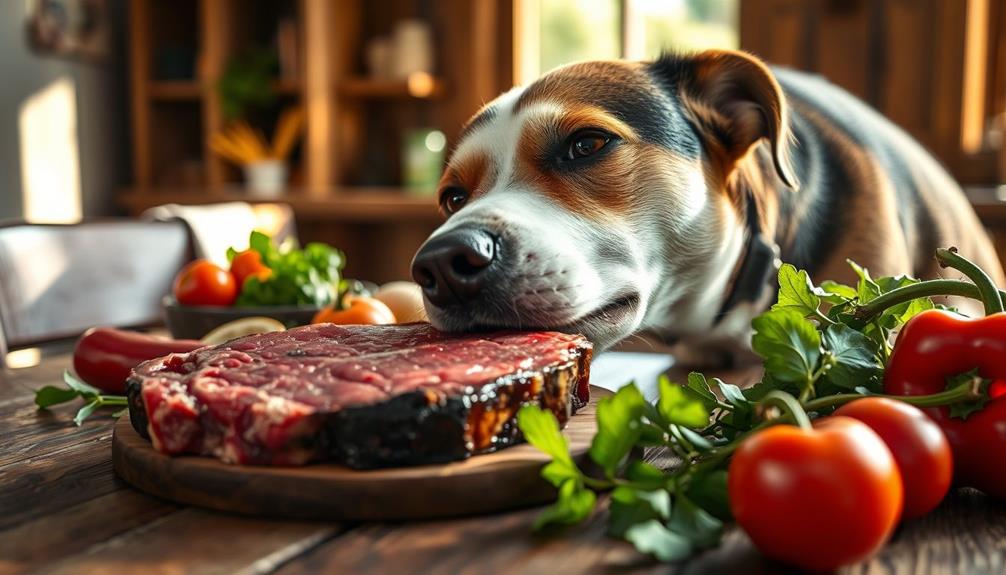
Many pet owners mistakenly think that feeding their animals raw meat is entirely safe and natural. However, even carnivorous species can suffer from health risks associated with raw diets. Foodborne pathogens like Salmonella and E. coli can pose serious threats to your pet's health, despite their evolved digestive systems that allow them to handle raw meat better than humans.
Moreover, the belief that raw meat offers a more natural diet overlooks the potential for nutritional imbalances. Unbalanced raw diets can lead to deficiencies in essential vitamins and minerals, which could result in long-term health issues.
While some cultures advocate for raw meat consumption, the long-term effects on animal health remain under-researched, prompting many veterinarians to advise caution.
It's essential to understand that raw diets may actually increase rates of bacterial shedding and other complications. This is why seeking veterinary guidance is pivotal before making any significant changes to your pet's diet.
Don't let misconceptions about raw meat lead to avoidable health issues for your beloved companion; informed choices are key to their well-being.
Safety Measures for Raw Feeding

When considering a raw food diet for your pet, it's important to prioritize safety measures to prevent health risks. Raw diets can pose risks of bacterial contamination, so adhering to strict hygiene practices is imperative.
Here are some important safety measures to keep in mind:
- Always wash your hands before and after handling raw food.
- Clean food preparation areas and feeding bowls regularly to minimize contamination.
- Consider freezing or dehydrating raw pet food to reduce bacterial counts, but remember, this doesn't eliminate them entirely.
- High Pressure Processing (HPP) can serve as a safer alternative, greatly reducing pathogens without cooking.
- Be extra cautious if you have young children, the elderly, or immunocompromised individuals in your household.
As a pet owner, it's crucial to monitor your pet's health and well-being through regular veterinary check-ups.
These check-ups guarantee that safety measures are consistently followed and help to address any concerns related to raw diets. By implementing these practices, you can enjoy the benefits of raw feeding while keeping both your pet and family safe.
Veterinary Perspectives on Raw Diets

Veterinarians often raise important concerns about raw meat-based diets (RMBDs) for pets, emphasizing the potential health risks linked to bacterial contamination. Studies have shown that nearly 6% of raw dog diet samples test positive for Salmonella, which can pose serious threats to both pets and humans.
While some pet owners report healthier pets on RMBDs, veterinarians stress the absence of level 1 evidence from randomized controlled trials that evaluate the risks and benefits of these diets.
Organizations like the American Veterinary Medical Association discourage raw diets, particularly in households with vulnerable individuals, as the health risks can extend beyond pets.
Client education is essential to inform pet owners about proper hygiene practices, since standard cleaning methods mightn't effectively eliminate harmful pathogens like Salmonella from feeding areas and utensils.
To guarantee accountability, veterinarians are encouraged to document dietary recommendations and client decisions regarding RMBDs in medical records. This practice facilitates informed discussions about pet nutrition, helping you make the best choices for your furry friends while considering potential risks associated with raw diets.
Bacterial Contamination Concerns

When you feed your pet a raw food diet, you might unknowingly introduce harmful bacteria like Salmonella and E. coli into your home.
These contaminants can pose serious health risks not just to your pet but also to you and your family. Understanding the sources of these bacteria and the potential risks is essential for keeping everyone safe.
Contamination Sources Identified
Raw food diets for pets can be a double-edged sword, offering potential benefits while also posing significant health risks due to bacterial contamination.
When you choose to feed your pet raw food, it's essential to be aware of the sources of contamination that can lead to illnesses, particularly from bacteria like Salmonella.
Here are some common contamination sources to take into account:
- Raw Meat Products: Studies show that nearly 80% of raw chicken diets contain Salmonella.
- Environmental Contamination: A study found 6% of raw meat dog diet samples tested positive for Salmonella.
- Fecal Shedding: Dogs on a raw diet may shed Salmonella in their feces for up to two weeks after exposure.
- Improper Handling: Cross-contamination can occur if feeding bowls and preparation areas aren't cleaned properly.
- Human Interaction: Pets can transmit bacteria to you through contact, increasing health risks to humans.
Risks to Human Health
Feeding pets raw diets can lead to serious health risks for humans, especially when it comes to bacterial contamination. The risks of contamination are significant, with studies showing that nearly 80% of raw chicken diets test positive for Salmonella.
When pets consume these raw meat diets, they can shed harmful bacteria like Salmonella in their feces, creating a potential transmission route to humans. This is particularly concerning for young children and those with weakened immune systems, as they're more vulnerable to infections.
Moreover, pathogens such as E. coli and Campylobacter have been found in both commercial raw diets and human-grade meat, raising serious food safety concerns.
Standard cleaning methods often fall short in eliminating these bacteria from feeding bowls and preparation areas, making proper hygiene practices essential. The rising incidents of Salmonella linked to raw meat-based diets have led various veterinary associations to discourage their use, highlighting the importance of food safety for both pets and humans.
Ultimately, remember that humans can't afford to overlook these risks when considering pet foods that include raw ingredients.
Raw Diets in Companion Animals
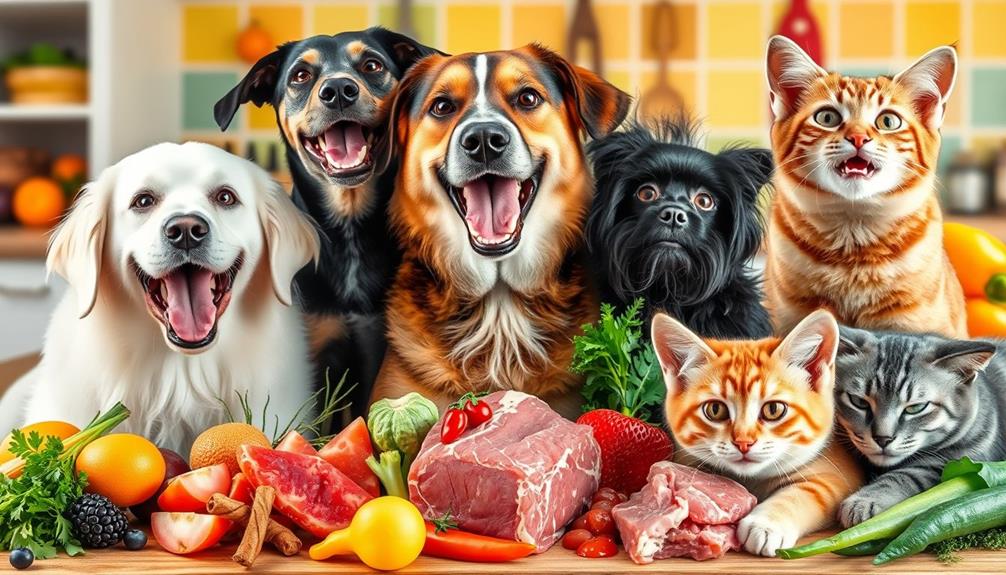
The trend of raw meat-based diets (RMBDs) for companion animals is gaining traction among pet owners, with studies showing that 15%-25% of dogs and 10% of cats now enjoy these diets.
While raw meat can provide vital nutrients, you must be cautious. Many homemade raw diets lack nutritional completeness, with nearly 70% falling short of nutritional recommendations.
When considering RMBDs, keep these points in mind:
- Health Benefits: Raw diets can offer bioavailable nutrients beneficial for your pet's overall health.
- Nutritional Imbalances: Owners often add raw eggs or meat without consulting a veterinarian, leading to potential imbalances.
- Bacterial Risks: Raw diets can expose pets to pathogens like Salmonella, with risks extending to human health through fecal shedding.
- Hygiene Practices: It's important to implement safe food handling to minimize bacterial exposure.
- Commercial Diets: Consider commercially prepared raw diets that meet safety and nutritional standards.
Before switching to a raw diet, it's important to weigh the risks of feeding and consult with a veterinarian to guarantee a balanced and safe approach for your furry friend.
Frequently Asked Questions
How Can Animals Eat Raw Food?
Animals eat raw food because their bodies are designed for it. Their strong stomach acids and efficient digestive systems break down nutrients quickly, while their evolved immune systems help protect them from harmful bacteria and pathogens.
What Are the Benefits of Raw Pet Food?
You'll discover that raw pet food can enhance your furry friend's health, boost their energy, and improve dental health. Plus, it may help address food sensitivities, ensuring your pet thrives on a well-rounded diet.
Is Raw Food Better for Animals?
You might find raw food beneficial for animals, as it can enhance their energy levels and improve coat health. However, it's essential to weigh the potential risks and guarantee proper handling to avoid health issues.
Can Food We Get From Animals Be Eaten Raw?
Yes, you can eat certain animal products raw, like sushi-grade fish, but it's essential to guarantee they're properly sourced and handled. Always prioritize safety to minimize health risks associated with consuming raw food.
Conclusion
In a world where nature often mirrors ancient tales, understanding how animals thrive on raw food reveals the wisdom of their evolution. Just as a lion hunts with precision, your pet can benefit from a carefully managed raw diet, embracing the primal instincts that lie within. However, you must tread carefully, aware of the risks and safety measures. By doing so, you can unveil the secrets of nutrition and health, ensuring your furry companion thrives like the wild ones.
Rachael, the Editor in Chief of RachaelsRawFood.com, is an inspiring and passionate individual who has dedicated her life to promoting the benefits of a raw food lifestyle. Known for her vibrant and energetic personality, Rachael has built a strong online presence that has transformed her personal journey into a thriving community of raw food enthusiasts.
Raw Food Recipes
How to Feed Your Dog Raw Food on a Budget
Simplify your dog’s raw food journey with budget-friendly tips that will leave you wondering what other secrets await for optimal nutrition.
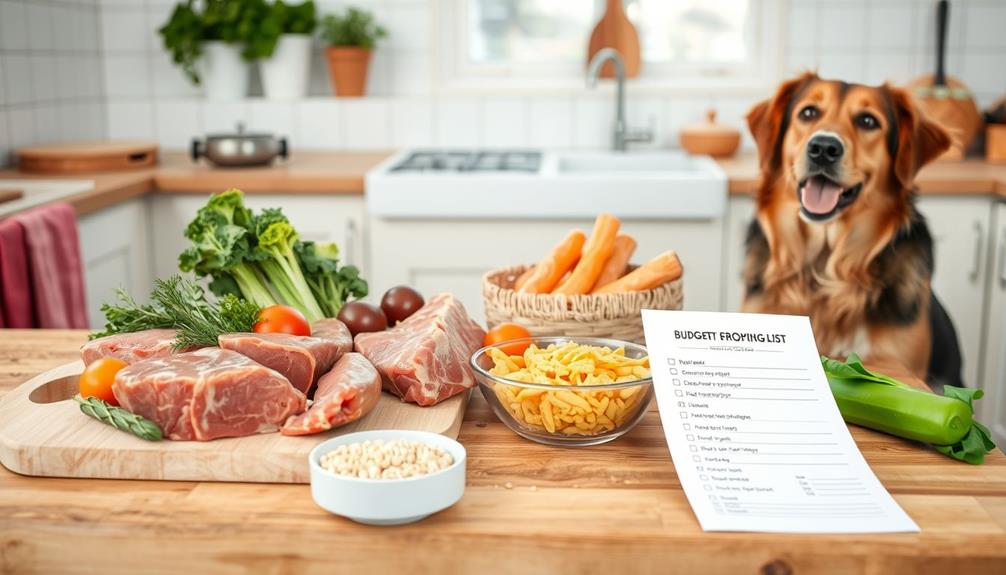
Feeding your dog a raw diet on a budget is doable with some smart choices. Start by buying ingredients in bulk from local suppliers to save money. Incorporate affordable protein sources like chicken, turkey, and even chicken feet. Use raw food as a topper for existing dry food to enhance nutrition without breaking the bank. Plan meals ahead of time to minimize waste and take advantage of seasonal sales. Don't forget to include fruits and vegetables for added nutrients. If you're curious about more tips and techniques to optimize your dog's raw diet, there's plenty more to explore.
Key Takeaways
- Purchase raw ingredients in bulk from local suppliers to reduce costs and take advantage of discounts.
- Use raw food as a topper for dry kibble to enhance nutrition without fully transitioning.
- Incorporate affordable protein sources like chicken feet, turkey scraps, and organ meats for balanced nutrition.
- Meal plan and portion out raw food to minimize waste and optimize usage.
- Rotate protein sources to provide variety and prevent meal fatigue while ensuring balanced nutrition.
Budget-Friendly Raw Feeding Strategies
Feeding your dog a raw diet doesn't have to break the bank. You can easily incorporate affordable raw dog food into your routine without stretching your finances. Start by using raw ingredients as a topper for your dog's existing dry food. This method boosts nutrition while keeping costs manageable.
Additionally, consider the benefits of including fresh fruits and vegetables, which can enhance your dog's diet and provide essential nutrients proper diet for pets.
Consider purchasing raw ingredients in bulk from local suppliers. This strategy often allows you to take advantage of discounts, greatly reducing long-term expenses. Look for budget-friendly protein sources like chicken, turkey, and tripe, which are typically cheaper than lamb or venison.
Don't overlook inexpensive raw options like chicken feet and carcasses; they offer great nutritional benefits without the hefty price tag.
Rotating proteins is another effective strategy. By buying variety boxes, you guarantee a balanced diet for your dog while lowering overall costs. Keep an eye on your grocery store for sales or special offers on these protein sources.
Feeding raw can be both economical and nutritious, so with a little planning and creativity, you can provide your dog with a healthy diet that fits your budget.
Bulk Buying and Meal Planning
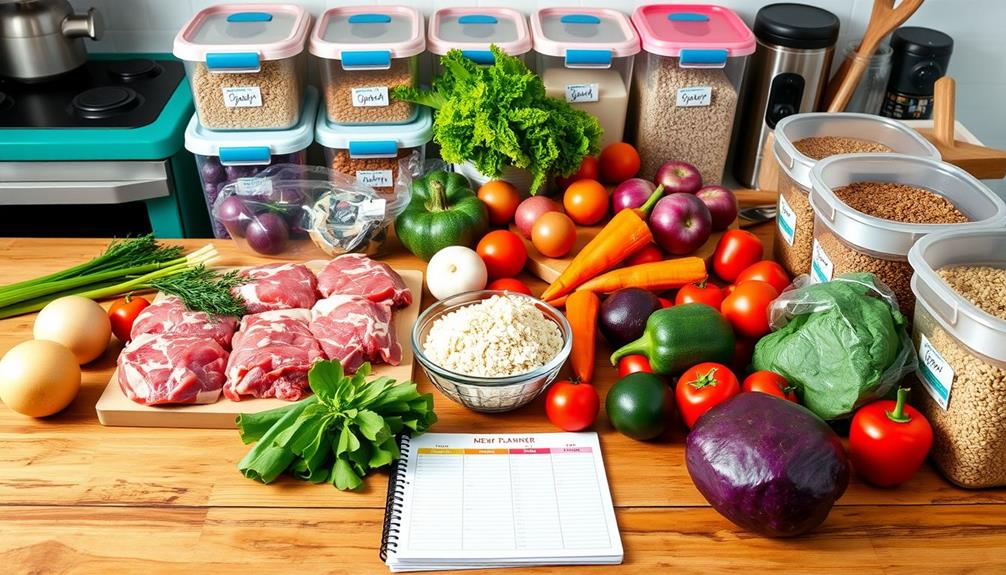
Bulk buying raw dog food can be a game changer for your budget and your dog's nutrition. When you opt for buying in bulk, like 18 lb bulk boxes or 5 lb patties, you not only save money but also simplify your meal planning.
This approach is especially beneficial for pet owners of healthy dog snacks that require consistent nutrition. It makes it easier to maintain a balanced raw food diet for your dog without worrying about constant grocery trips.
Thawing and measuring portions from bulk purchases helps you accurately feed your dog while minimizing waste. It encourages a consistent feeding routine, which is vital for your pet's health.
Plus, having a large freezer for freeze storage is ideal—especially in multi-pet households—allowing you to stock up without cluttering your kitchen.
Meal planning becomes a breeze when you buy in bulk. You can try different raw meals and identify your dog's preferred protein sources, ensuring they get the nutrition they need.
Just remember to prioritize food safety by properly storing and handling the meat. For pet parents looking to provide quality nutrition on a budget, bulk buying and effective meal planning are essential strategies to contemplate.
Affordable Protein Sources
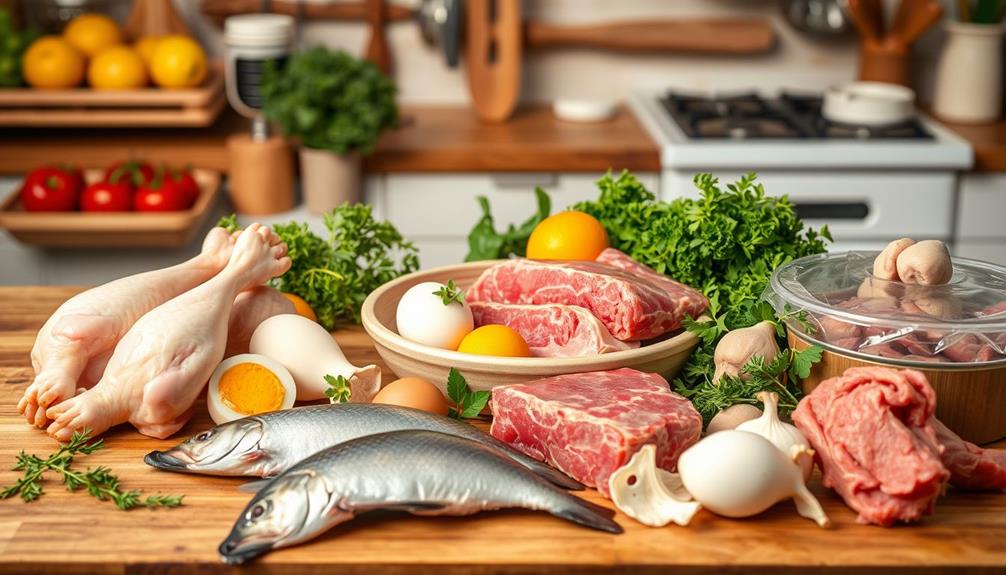
When it comes to feeding your dog raw food on a budget, finding affordable protein sources is key.
Emphasizing natural ingredients, just like the modern farmhouse decor trends in home design, can help you create a wholesome diet for your pup.
Chicken, beef, and even seasonal game meats can cut costs while keeping your pup healthy.
Budget Protein Options
Finding affordable protein options for your dog's raw diet can really help stretch your budget. Incorporating a variety of protein sources not only keeps costs down but also guarantees your pup gets essential nutrients. Here are some budget-friendly protein options to take into account:
| Protein Source | Benefits | Cost-Effectiveness |
|---|---|---|
| Chicken | Economical and versatile | High availability |
| Ground Meat | Includes turkey and pork | Affordable alternatives |
| Chicken Feet | Rich in calcium and nutrients | Low-cost option |
| Fish Scraps | Great source of omega-3s | Often discarded, cheaper |
| Rotating Proteins | Prevents meal fatigue | Maintains balanced diet |
When you choose budget protein options like chicken and ground meat, you can create balanced meals without breaking the bank. Don't forget to include chicken feet or necks for added calcium. Fish scraps from local markets can also provide variety and essential fatty acids. By regularly rotating these affordable protein sources, you're guaranteeing your dog gets the nutrition they need while keeping your expenses manageable.
Seasonal Ingredient Savings
Exploring seasonal ingredient savings can greatly enhance your dog's raw diet while keeping costs low. One of the best ways to find budget-friendly protein is by incorporating seasonal game meats during hunting seasons. These options are often less expensive and can provide excellent nutrition.
Additionally, don't overlook holiday sales for chicken and turkey; stocking up during these times can markedly reduce your protein costs. Incorporating nutrient-rich organ meats like liver can also be a cost-effective way to boost your dog's diet.
Local farmers' markets are another great resource. They frequently offer discounts on fresh, in-season produce that can add crucial nutrients to your dog's meals. You can also find organ meats, like liver, at local butchers, which are often cost-effective and enhance the nutrient density of your homemade raw food.
If you have the storage space, consider bulk buying opportunities for proteins like beef and chicken. Purchasing larger quantities during sales events can lead to impressive savings.
Health Benefits of Raw Diet
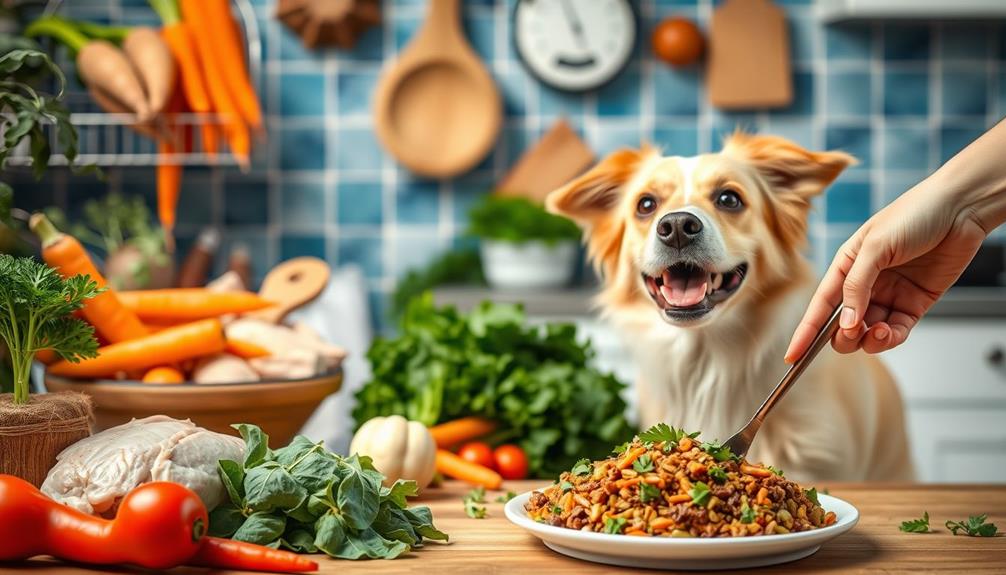
Feeding your dog a raw diet can bring a host of health benefits that enhance their overall well-being. When dogs eat raw meat, they often experience improved digestion and reduced allergy symptoms, thanks to the natural enzymes and nutrients found in these foods. A balanced raw diet supports a stronger immune system, which can lead to fewer veterinary visits and lower healthcare costs over time.
Additionally, incorporating certain aspects of cold medications overview can help address any seasonal allergies that may arise, further improving your dog's health.
Moreover, a raw diet promotes dental health. The natural chewing of raw bones helps reduce plaque and tartar buildup, resulting in cleaner teeth and fresher breath. You'll also notice that dogs consuming a raw diet tend to have smaller, firmer feces, making clean-up easier for you.
Additionally, many pet owners report increased energy levels and liveliness in their dogs after switching to raw food. This boost in energy contributes to a more active lifestyle, enhancing your dog's overall quality of life.
Choosing Raw Dog Food Brands
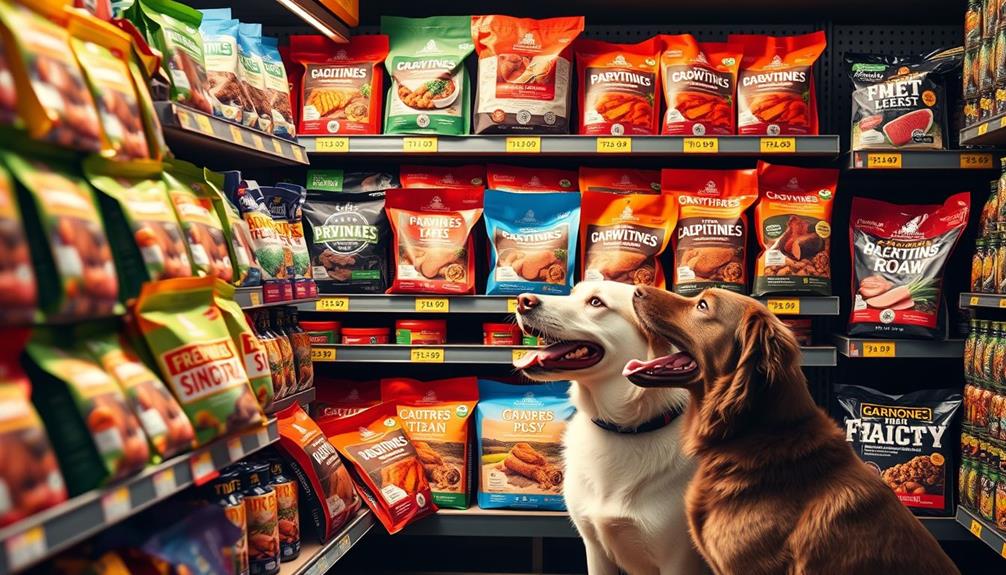
When it comes to adopting a raw diet for your dog, choosing the right food brand is just as important as understanding its health benefits. Start by prioritizing raw dog food brands that emphasize high-quality sourcing and transparent ingredient lists. This guarantees your furry friend gets nutritious and safe meals.
Look for brands with HACCP certification, which signifies they meet strict food safety standards during production. Additionally, consider brands that offer a variety of proteins to promote diversification strategy in your dog's diet, as this can help prevent allergies and provide complete nutrition.
It's also wise to check customer reviews and testimonials. These insights can help you gauge the effectiveness and palatability of different raw food brands.
When comparing options, focus on the nutritional profiles, paying close attention to the balance of proteins, fats, and essential vitamins. This will help you find the best fit for your dog's dietary needs.
Cost-Saving Tips for Raw Feeding

Raw feeding your dog doesn't have to break the bank. You can maximize your savings by purchasing raw ingredients in bulk from local suppliers. Buying larger quantities usually lowers the price per pound, which helps you stick to your budget.
Focus on affordable protein sources like chicken and beef, as they're often cheaper than options like lamb or venison. Additionally, consider exploring financial considerations for elderly care to help gauge how to manage expenses effectively.
To further manage costs, consider using raw food as a topper for your dog's existing dry food. This approach boosts nutrition without requiring a full switch to an all-raw diet. You might also try feeding one raw meal a day instead of two. This simple change can markedly reduce your overall food costs while still providing health benefits for your dog.
Another savvy tip is to team up with other dog owners. Share bulk purchases to take advantage of discounts, ensuring you have a variety of meats without incurring high individual costs.
Frequently Asked Questions
How to Afford to Feed Your Dog Raw?
Feeding your dog raw doesn't have to break the bank. Buy in bulk, focus on affordable proteins, and consider sharing costs with fellow dog owners. You'll find creative ways to keep expenses manageable while enhancing nutrition.
How to Make Cheap Raw Dog Food?
To make cheap raw dog food, buy bulk protein like chicken and turkey. Mix bone-in meat with organ meat and veggies for balance, and look for seasonal sales or discounts to save even more.
How Can I Save Money on Raw Dog Food?
You can save money on raw dog food by buying in bulk, choosing affordable protein sources, sharing costs with other owners, using raw food as a topper, and watching for seasonal sales on ingredients.
Is It Cheaper to Make or Buy Raw Dog Food?
It's generally cheaper to make raw dog food than to buy it. You can control costs by sourcing ingredients in bulk and creating balanced meals at home, which often saves you money compared to pre-packaged options.
Conclusion
As you commence on this journey of feeding your dog raw food, think of it as planting a garden. With careful planning and nurturing, you'll reap the rewards of health and energy for your furry friend without breaking the bank. Embrace bulk buying and affordable protein sources as your seeds, and watch them flourish into a thriving lifestyle. By investing time and effort, you're not just feeding your dog; you're cultivating a bond that blooms with every meal.
Rachael, the Editor in Chief of RachaelsRawFood.com, is an inspiring and passionate individual who has dedicated her life to promoting the benefits of a raw food lifestyle. Known for her vibrant and energetic personality, Rachael has built a strong online presence that has transformed her personal journey into a thriving community of raw food enthusiasts.
Raw Food Recipes
What Are Raw Foods List? Find Out Here
Open the door to a vibrant world of raw foods that enhance your health, and uncover the essential ingredients to elevate your diet today.

Raw foods are fresh, unprocessed items that keep their natural nutrients, offering a healthy way to eat. A typical raw foods list includes fresh fruits like apples and bananas, an array of colorful vegetables such as cucumbers and carrots, and nutrient-dense nuts and seeds. You can also explore dried fruits, sprouted grains, and even seaweeds for added variety. These foods not only provide essential vitamins and antioxidants but also promote better digestion and hydration. There's so much more to discover about incorporating raw foods into your diet for health benefits that you'll want to learn about next.
Key Takeaways
- Raw foods include fresh fruits and vegetables that are unprocessed and uncooked, preserving their natural nutrients.
- Common raw foods consist of nuts, seeds, sprouted grains, and dried fruits without added oils or preservatives.
- Nutrient-dense options like seaweeds, edible algae, and fresh herbs enhance flavors and provide essential vitamins.
- Superfoods like maca and barley grass powder offer additional health benefits and can be included in a raw food diet.
- Raw honey and agave syrup serve as healthier natural sweeteners in raw food preparations.
Understanding Raw Foods
When you explore the world of raw foods, you'll discover a vibrant array of unprocessed and uncooked items that retain their natural nutrients and enzymes. Raw foods, typically prepared below 115°F, offer numerous health benefits that can enhance your overall well-being.
For instance, incorporating fresh fruits like apples and bananas can provide essential vitamins and antioxidants, similar to the benefits of Cranberry Juice Consumption. By focusing on organic and seasonal produce, you not only maximize flavor but also minimize exposure to harmful pesticides and chemicals.
Adopting a raw food diet can lead to higher fiber intake, which aids digestion and promotes a feeling of fullness. This can be particularly beneficial for weight management and improved gut health.
You'll find that fresh fruits like apples and bananas, vegetables such as cucumbers and leafy greens, and raw nuts and seeds are staples of this lifestyle.
Preparation methods like juicing, blending, dehydrating, soaking, and sprouting help enhance flavor and texture while keeping the nutrients intact. Engaging with raw foods encourages a more mindful approach to eating, allowing you to connect with the natural goodness of your meals.
Common Raw Foods You Can Find
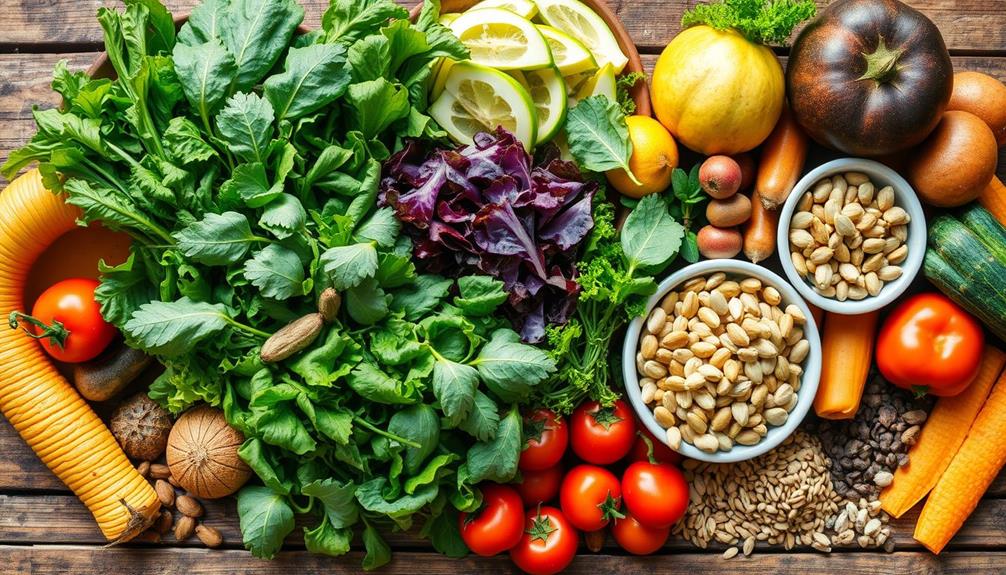
When you explore common raw foods, you'll discover a vibrant array of fresh fruits and vegetables like apples, carrots, and tomatoes that pack essential nutrients.
Incorporating herbal teas into your diet can also provide numerous health benefits.
Nuts and seeds, such as unroasted almonds and sesame seeds, offer a great source of healthy fats and protein.
Don't forget about dried fruits like prunes and raisins, which can add a sweet touch to your meals as long as you choose the right ones.
Fresh Fruits and Vegetables
What fresh fruits and vegetables can you easily incorporate into your diet? Start with common raw fruits like apples and pears, which are rich in vitamins, fiber, and antioxidants. These fruits not only satisfy your sweet tooth but also contribute to your overall health.
You might also consider adding safe snacks for pets that can inspire you to try new fruits and vegetables that promote health for both you and your furry friends.
When it comes to vegetables, consider adding carrots, salad greens, bok choy, and tomatoes to your meals. These fresh vegetables are low in calories yet packed with essential nutrients, making them perfect for a raw food diet. You can enjoy them in salads, wraps, or as crunchy snacks.
If you want to mix things up, think about including sprouted items like quinoa and alfalfa sprouts. They're loaded with nutrients and enzymes, enhancing the health benefits of your meals.
Fresh herbs, such as parsley and basil, are also great additions. They elevate the flavor of your dishes while offering antioxidant properties.
While dried fruits like prunes and raisins can be tempting, always choose varieties that haven't been treated with vegetable oils. By focusing on these fresh fruits and vegetables, you'll create delicious and nutritious raw foods that support a healthy lifestyle.
Nuts and Seeds
Nuts and seeds are fantastic additions to a raw food diet, providing a rich source of healthy fats, protein, and essential nutrients. Common raw nuts include unroasted almonds, walnuts, and cashews, all of which are packed with the goodness your body craves.
Additionally, incorporating various coffee varieties can enhance your overall health journey, as they offer unique flavor profiles and aromas. When it comes to seeds, options like sesame seeds and poppy seeds are also considered raw foods, offering a wealth of vitamins, minerals, and fiber.
When you're shopping for nuts and seeds, make sure to choose the raw varieties. Roasted options often come with added oils and preservatives that can detract from their nutritional value.
Soaking raw nuts before consuming them can further enhance digestibility and nutrient absorption, making them even more beneficial in your raw food diet.
Both nuts and seeds are incredibly versatile, serving as crunchy additions to smoothies, salads, or snacks. You can sprinkle them on top of your favorite dishes or blend them into creamy nut butters.
Dried and Dehydrated Options
Incorporating dried and dehydrated options into your raw food diet can elevate both flavor and nutrition. Dried fruits like prunes and raisins are popular choices, but make sure to avoid those treated with vegetable oils to keep them truly raw. These fruits offer natural sweetness and can be great additions to snacks or salads.
Additionally, it's important to be mindful of sugar content in dried fruits, as some can be quite high, impacting your overall health and wellness sugar overload can lead to health issues.
Dehydrated vegetables, such as dried mushrooms and chilis, retain their nutrients while providing concentrated flavors. You'll find that these versatile ingredients can enhance soups, sauces, or even serve as toppings for your dishes.
Additionally, dried seaweeds like dulse and nori are excellent sources of minerals and vitamins, often available in the Asian section of your local supermarket.
Don't forget about sprouted items, like quinoa and soaked almonds, which pack extra nutritional benefits and are easily found in health food stores.
Finally, raw nuts and seeds, such as unroasted almonds and sesame seeds, are perfect for snacking and can be incorporated into various recipes for added texture and nutrition.
With these options, you can spice up your raw food meals while enjoying the health benefits they offer.
Supermarket Raw Food Options
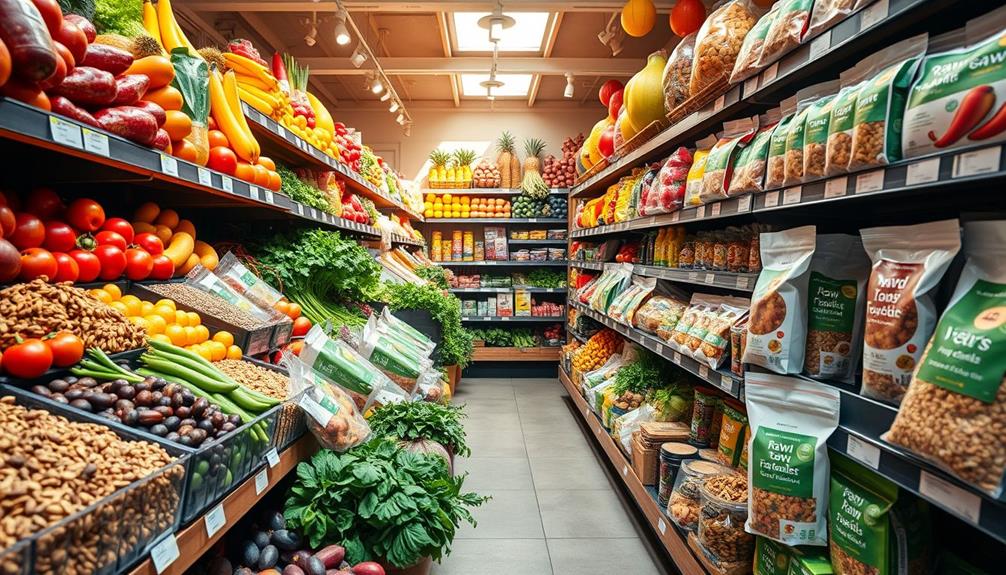
When you head to the supermarket, you'll likely find a great selection of fresh produce, from crisp salad greens to juicy berries, that are perfect for your raw food diet.
Additionally, exploring the vast array of options can be reminiscent of the diverse brewing methods coffee enthusiasts enjoy.
Many stores also offer prepackaged options like nut butters and dehydrated snacks, making it easy to grab something quick.
Don't forget to check the specialty sections for unique oils and ingredients that can elevate your raw dishes!
Fresh Produce Availability
Exploring the fresh produce aisle in supermarkets reveals a treasure trove of options perfect for a raw food diet. You can find a variety of fresh fruits and vegetables that are not only delicious but also packed with essential nutrients. Staples like apples, pears, and bananas serve as great snacks, while salad greens, carrots, and tomatoes provide crucial vitamins. Fresh herbs like parsley and basil can elevate your raw dishes, adding depth to your meals.
Here's a quick look at some common fresh produce available:
| Category | Examples | Benefits |
|---|---|---|
| Fresh Fruits | Apples, Bananas, Pears | High in vitamins and fiber |
| Fresh Vegetables | Salad Greens, Carrots, Bok Choy | Rich in minerals and antioxidants |
| Sprouted Grains & Nuts | Quinoa, Alfalfa Sprouts, Almonds | Packed with protein and healthy fats |
Additionally, don't forget about oils and spices like olive oil and cayenne pepper to enhance your salads. With these fresh options, you can easily create nutritious, satisfying raw meals that keep your energy up throughout the day.
Packaged Raw Food Options
While fresh produce offers a strong foundation for your raw food diet, packaged raw food options can add convenience and variety to your meals. Supermarkets have expanded their offerings, making it easier for you to incorporate raw foods into your routine.
For instance, you might contemplate adding essential oils for hair growth to your diet as a natural way to enhance overall health. Here are some great options to contemplate:
- Nut Butters: Look for nut butters made from unroasted nuts to maintain nutrient integrity and healthy fats.
- Dehydrated Crackers: Find crunchy snacks made from raw ingredients in health food aisles—perfect for satisfying your cravings without cooking.
- Fresh Herbs: Enhance your dishes with fresh herbs like parsley and basil found in the produce section, boosting flavor and nutrition.
- Sprouted Items: Check for pre-packaged quinoa or alfalfa sprouts, which can elevate salads and wraps with their nutrient density.
You'll also discover oils like olive oil and avocado oil, suitable for adding healthy fats to your raw food preparations.
Specialty Item Sections
Specialty item sections in supermarkets are treasure troves for raw food enthusiasts, offering a diverse selection of ingredients that elevate your meals. You'll find an array of fresh fruits, like apples and bananas, alongside vibrant veggies such as leafy greens and cucumbers.
These raw foods not only provide essential nutrients but also make for colorful dishes. Additionally, incorporating fresh produce into your diet can help promote emotional well-being, which is crucial for individuals managing conditions like BPD.
Look for sprouted items, like quinoa and alfalfa sprouts, in these sections. They pack enhanced nutritional benefits that can boost your overall health. Fresh herbs, including parsley and basil, are also common and can greatly enhance the flavor of your raw dishes while adding crucial nutrients.
Don't overlook the oils available, like olive oil, avocado oil, and hemp oil. These healthy fats are perfect for drizzling over your meals or using in dressings.
For convenience, prepackaged raw foods, such as nut butters and dehydrated crackers, make excellent snacks that align with your plant-based foods lifestyle.
Wild and Sea Foods Available

When you immerse yourself in the world of wild and sea foods, you'll discover a treasure trove of nutritious options that can elevate your raw food diet.
These foods not only enhance your meals but also provide essential nutrients your body craves. Incorporating a variety of fresh ingredients can support overall health and well-being, especially when reflecting on different dietary needs and preferences, including cold medications overview.
Here are some exciting options to contemplate:
- Wild Foods: Foraged delights like dandelion greens are packed with vitamins and minerals, making them a fantastic addition to salads or smoothies.
- Seaweeds: Varieties such as dulse, nori, and sea spaghetti are often found in the Asian section of supermarkets and are rich in iodine, supporting thyroid health.
- Edible Algae: Spirulina and chlorella come in powdered form and are known for their high protein content, perfect for boosting smoothies or energy snacks.
- Health Food Stores: These stores typically offer a diverse selection of wild and sea foods, allowing you to expand your raw food repertoire and experiment with new flavors.
Less Common Raw Foods

Exploring less common raw foods can add exciting new dimensions to your diet, enhancing both flavor and nutrition. Consider incorporating nutrient-dense algaes like spirulina and chlorella into your meals. These superfoods are often available in powder form and are packed with antioxidants, making them a great addition to smoothies or salads.
Additionally, incorporating foods that support overall health, such as balanced diet, can further enhance the benefits of your raw food choices.
You might also want to experiment with edible flowers, such as zucchini blossoms and lavender flowers. They not only bring unique flavors to your dishes but also add a beautiful visual appeal.
Another fantastic option is to include superfoods like maca and barley grass powder, both rich in essential vitamins and minerals. These can elevate your meals while providing significant health benefits.
For those who enjoy a touch of sweetness, raw honey and agave syrup serve as healthier alternatives to refined sugars. These natural sweeteners fit perfectly into a raw food lifestyle and can enhance the taste of various dishes.
You can easily find these less common raw foods in specialty stores or online platforms like Amazon, making it convenient to diversify your raw food options.
Embrace these unique ingredients to enrich your culinary experience!
Nutritional Benefits of Raw Foods
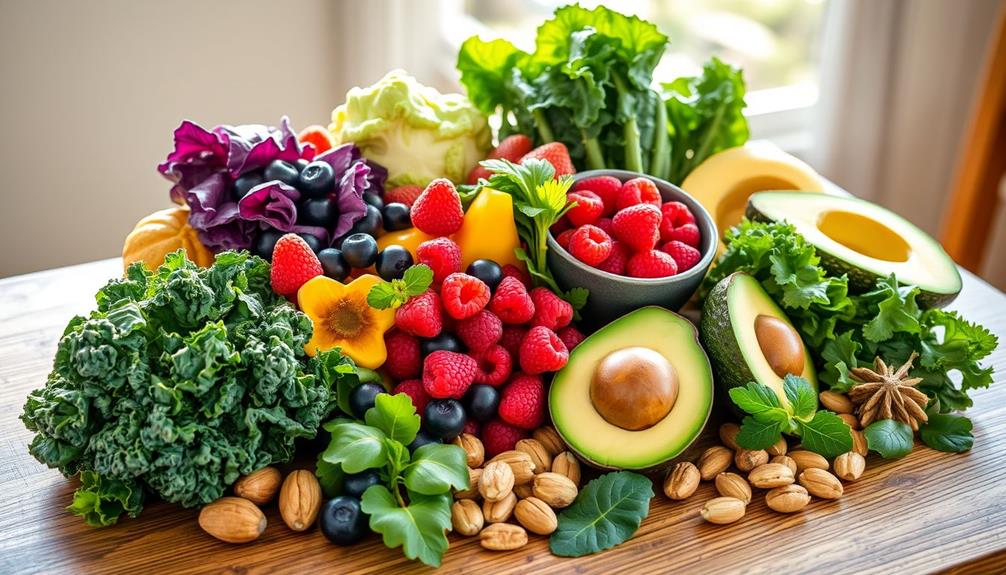
When you choose raw foods, you're benefiting from high nutrient retention that keeps essential vitamins and minerals intact.
This approach not only enhances your digestive health with increased fiber but also helps you feel fuller for longer.
High Nutrient Retention
Raw foods offer a remarkable advantage in nutrient retention, making them a powerful choice for anyone seeking to boost their health. By choosing raw foods, you can take full advantage of the vitamins, minerals, and enzymes that cooking often diminishes.
Here are some key benefits of high nutrient retention in raw foods:
- Enhanced Nutrient Availability: Raw foods retain more essential nutrients compared to their cooked counterparts, promoting overall health.
- Rich in Antioxidants: Many raw foods, like leafy greens and colorful fruits, are packed with antioxidants that combat oxidative stress and inflammation.
- Weight Management: The low caloric density of raw foods provides essential nutrients without excess calories, helping you manage your weight while maintaining energy levels.
- Hydration: With high water content, raw foods contribute to hydration, which is vital for peak bodily functions.
Enhanced Digestive Health
Incorporating raw foods into your diet can greatly enhance your digestive health. These foods are packed with dietary fiber that promotes regular bowel movements and helps prevent constipation. Plus, many raw fruits and vegetables have high water content, which keeps you hydrated and supports digestion.
The enzymes found in raw foods, like bromelain in pineapples and papain in papayas, can break down proteins, improving your nutrient absorption. Eating a variety of raw foods also nurtures a diverse gut microbiome, essential for effective digestion and overall gut health.
Here's a quick overview of how raw foods benefit your digestive health:
| Benefit | Description |
|---|---|
| High Fiber Content | Promotes regular bowel movements |
| Hydration | Supports digestion through high water content |
| Digestive Enzymes | Aids in protein breakdown and nutrient absorption |
| Gut Microbiome Diversity | Crucial for effective digestion and gut health |
Meal Preparation Tips
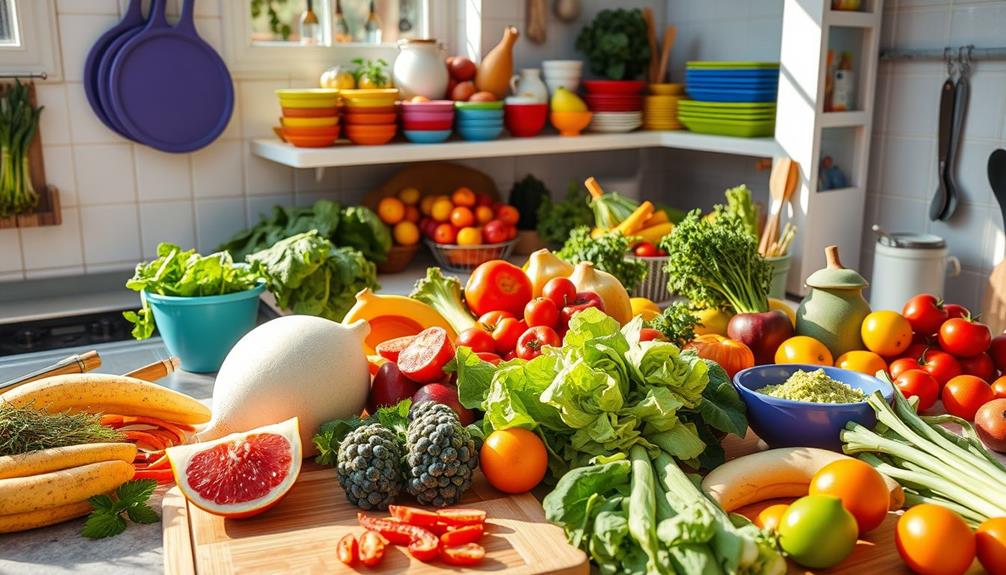
Preparing meals with raw foods can be an exciting way to embrace a healthier lifestyle while accommodating various dietary needs. Here are some meal preparation tips to help you get started:
1. Batch Prep Ingredients: Chop vegetables and soak nuts in advance. This makes it easier to assemble meals throughout the week, saving you time and effort.
2. Use Smart Techniques: Incorporate soaking, sprouting, and dehydrating methods to enhance the flavors and nutritional value of your raw foods.
These techniques can transform simple ingredients into delicious meals.
3. Invest in Quality Tools: A good blender and food processor can be game-changers. They'll help you whip up smoothies, dips, and raw desserts quickly and efficiently.
4. Flavor with Fresh Herbs: Elevate your raw dishes by incorporating fresh herbs and spices. They enhance taste without relying on processed foods, making your meals vibrant and exciting.
Health Benefits of Raw Diet
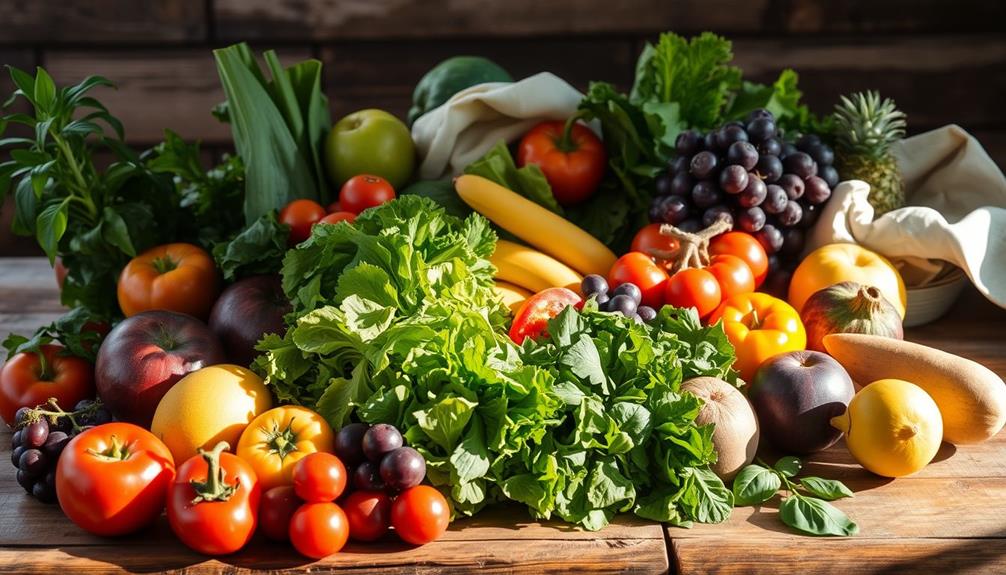
Embracing a raw diet can markedly enhance your overall health and well-being. By focusing on raw foods, you'll enjoy a plethora of benefits that can transform your life. This diet is rich in fiber, which aids digestion and promotes regularity, potentially reducing gastrointestinal issues. Plus, raw fruits and vegetables retain higher levels of essential vitamins and antioxidants, giving your body the nutrients it craves.
Here's a quick overview of the benefits you'll experience:
| Health Benefit | Description | Impact on Your Life |
|---|---|---|
| Improved Digestion | High fiber content aids in digestive health | Feel lighter and more energetic |
| Enhanced Nutrient Intake | Raw foods have higher vitamin levels | Boost your immune system |
| Weight Management | Lower caloric density helps in weight control | Maintain a healthy weight |
| Reduced Inflammation | Elimination of processed foods lowers chronic disease risk | Promote long-term health |
Pros and Cons of Raw Eating
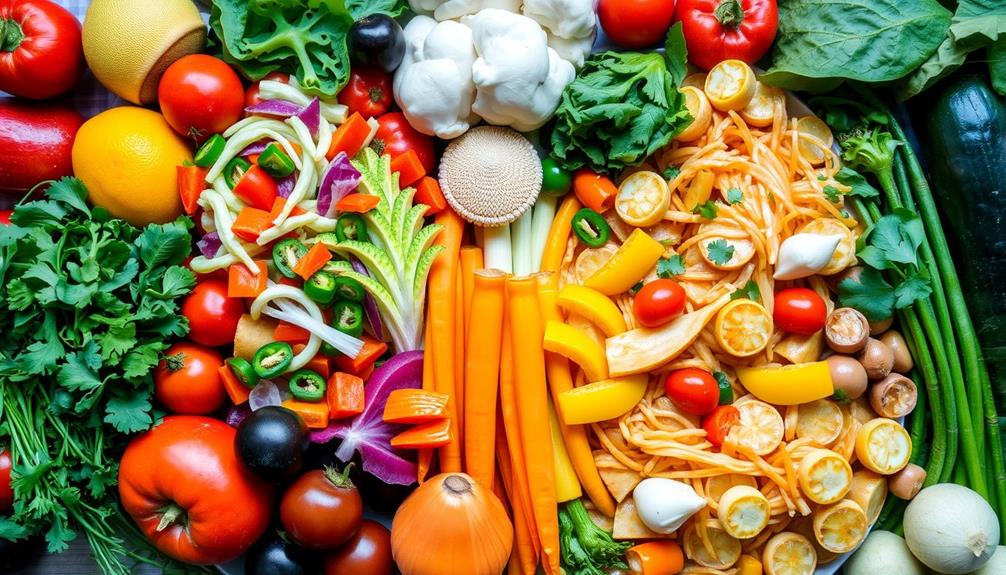
Raw eating offers a blend of benefits and challenges that can profoundly impact your lifestyle. Embracing a raw diet can lead to improved digestion, increased energy levels, and better overall health. However, it's crucial to evaluate the pros and cons before diving in.
Here are some key points to reflect on:
- Nutrient-Rich: Raw foods retain natural enzymes and nutrients, potentially aiding in weight management and reducing disease risks.
- High Fiber: The increased fiber intake can enhance digestion but may cause bloating or discomfort for some.
- Nutrient Deficiencies: A raw diet can lead to deficiencies, particularly in vitamin B12, iron, and omega-3 fatty acids, necessitating careful meal planning.
- Dining Challenges: Limited options when eating out and the time-intensive preparation of raw meals can make it hard to stick with this lifestyle.
Practical Tips for Beginners
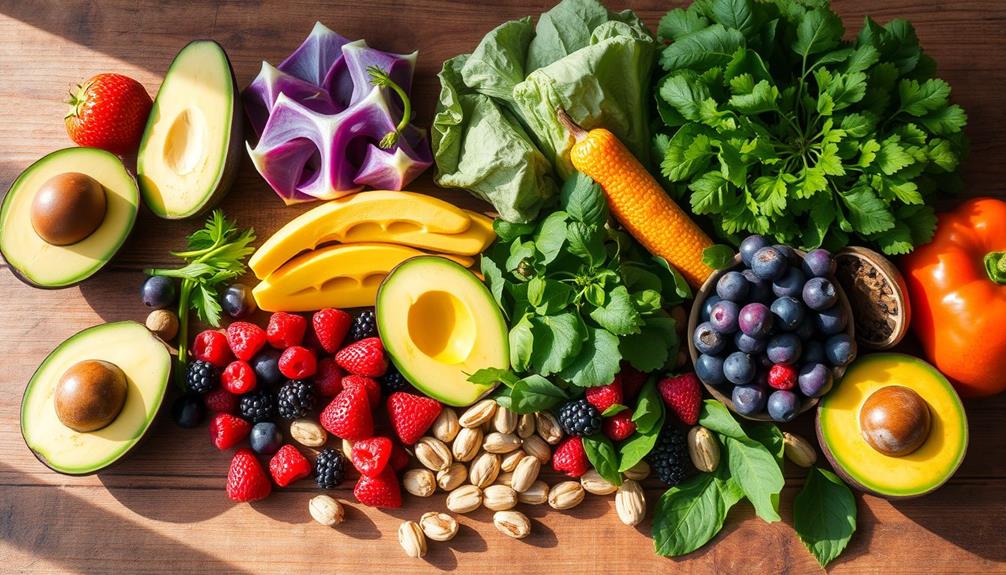
Shifting to a raw food diet can feel overwhelming, but starting small makes it manageable and enjoyable. Begin by incorporating one raw meal into your daily routine—try a raw breakfast smoothie or a fresh salad. This gradual approach helps you ease into raw foodism without feeling pressured.
Next, focus on stocking your kitchen with a variety of fresh fruits, vegetables, nuts, and seeds. Having plenty of raw foods on hand guarantees you won't struggle to whip up a meal at a time.
Investing in essential kitchen tools like a high-speed blender and food processor can simplify your meal prep, making it easier to create delicious raw snacks and dishes.
Don't forget to explore local and seasonal produce. Fresh ingredients not only enhance flavor but also provide better nutrition while keeping costs down.
Finally, consider joining online communities or local raw food groups. They can offer support, recipe sharing, and encouragement as you shift to this vibrant lifestyle.
Frequently Asked Questions
What Are Examples of Raw Foods?
When exploring examples of raw foods, you'll discover fresh fruits like apples, vegetables such as carrots, nuts and seeds including unroasted almonds, and sprouted items like quinoa, all providing essential nutrients for your diet.
What Counts as Raw Food?
Imagine a vibrant farmer's market. Raw food counts as fresh fruits, veggies, nuts, seeds, and sprouted grains. You'll also find seaweeds and natural sweeteners. These unprocessed options maximize nutrients and enhance your health.
Is Peanut Butter Considered Raw Food?
Peanut butter can be raw if it's made from raw peanuts without additives. Look for products labeled as "raw" or make your own by grinding raw peanuts, keeping their natural nutrients intact for a healthier choice.
What Is the Best Food to Eat Raw?
When you think about the best food to eat raw, consider fresh fruits like berries, leafy greens, crunchy vegetables, and nutritious nuts. These options offer vibrant flavors and essential nutrients, perfect for a healthy diet.
Conclusion
Incorporating raw foods into your diet can be a game-changer for your health. By focusing on fresh fruits, veggies, nuts, and seeds, you're tapping into nature's bounty—like finding a hidden treasure in your backyard! While it might take some time to adjust, the benefits can be well worth it. Just remember to balance your meals and listen to your body. So, why not give raw eating a shot? You might just discover a whole new world of flavors!
Rachael, the Editor in Chief of RachaelsRawFood.com, is an inspiring and passionate individual who has dedicated her life to promoting the benefits of a raw food lifestyle. Known for her vibrant and energetic personality, Rachael has built a strong online presence that has transformed her personal journey into a thriving community of raw food enthusiasts.
Raw Food Recipes
How Much Raw Food Should I Feed My Puppy? A Simple Guide
Beginning your puppy’s raw food journey? Discover the ideal portion sizes and essential tips for their health—your furry friend will thank you!

When you're feeding your puppy raw food, aim for about 5% to 10% of their body weight each day. For an 8-week-old pup, you might be closer to 10%, while a 6-month-old will likely need around 5%. It's important to monitor their weight weekly and adjust their portions as they grow. Puppies typically eat four meals a day until 16 weeks, then three meals until a year old. Make sure the food is high-quality, rich in proteins, fats, and vitamins. Stick around, and you'll uncover tips on the best practices for maintaining your puppy's health.
Key Takeaways
- Puppies typically require 5-10% of their body weight in raw food daily, adjusting as they grow.
- An 8-week-old puppy needs about 10% of body weight, while a 6-month-old may need around 4%.
- Monitor your puppy's weight weekly to adjust food portions according to growth and activity levels.
- Feed puppies aged 8 to 16 weeks 4 meals per day, reducing to 3 meals from 16 weeks to 12 months.
- Choose high-quality raw food with balanced nutrients and the right calcium to phosphorus ratio for optimal growth.
Understanding Puppy Nutritional Needs
When it comes to understanding puppy nutritional needs, it's important to remember that these little bundles of energy grow rapidly and require a specific balance of nutrients. Proper nutrition is essential for overall health and development, similar to how financial considerations for elderly care play a significant role in guaranteeing well-being later in life.
You should aim to feed your puppy around 4% to 10% of their body weight in food daily, depending on their age. For instance, an 8-week-old puppy might need about 10% of their body weight, while a 6-month-old may only require 4%.
By closely monitoring your puppy's weight weekly, you can adjust their feeding amounts to make sure they receive the best nutrition for healthy growth. A balanced diet for your puppy should include high-quality proteins, fats, carbohydrates, vitamins, and minerals. This variety supports their overall development and keeps them energetic and happy.
Don't overlook the importance of calcium and phosphorus ratios, as these minerals are critical for strong bone growth. Careful meal planning is necessary to meet these nutritional guidelines effectively.
Calculating Raw Food Portions

Calculating the right raw food portions for your puppy is vital to guaranteeing they receive the nutrition they need for healthy growth. Puppies typically require about 5-10% of their current body weight in raw food daily. Younger puppies need a higher percentage compared to older ones. For instance, a 3 kg puppy should be fed approximately 150 grams per day, calculated as follows:
| Body Weight (kg) | Daily Raw Food (grams) |
|---|---|
| 3 | 150 |
| 5 | 250 |
| 10 | 500 |
As your puppy grows, adjust the feeding amount; by 6 months, their requirement usually decreases to about 5% of body weight. It's vital to monitor your puppy's weight weekly to guarantee accurate feeding amounts. This way, you can make necessary adjustments based on their growth and activity levels. Using a puppy food calculator can also help determine the appropriate daily feed volume tailored to your puppy's weight and age, guaranteeing they receive the right nutrition during their developmental stages.
Feeding Frequency for Puppies

Feeding frequency plays a significant role in your puppy's growth and development. For puppies aged 8 to 16 weeks, it's crucial to feed your puppy 4 meals per day. This high frequency meets their energy and growth needs as they rapidly develop.
Additionally, guaranteeing a proper diet that includes a variety of nutrients is important for their health; consider the significance of proper diet for pets in planning their meals. As your puppy reaches 16 weeks to 12 months, you can reduce the feeding frequency to 3 meals per day, as their growth rate starts to slow down.
Once your puppy is between 12 to 18 months old, it's recommended to shift to 2 meals per day. This change helps maintain a balanced diet as your puppy matures into an adult dog.
Keep in mind that younger puppies may need to consume about 10% of their body weight in food daily, while this requirement reduces to around 4% by 6 months of age.
To guarantee your puppy is growing appropriately, make sure to conduct weekly weight checks. This practice allows you to adjust meal portions based on their age and activity level, helping you provide the right nourishment at every stage of their development.
Benefits of a Raw Diet

Many puppy owners are discovering the significant benefits of a raw diet, which can enhance your puppy's overall health and energy. One of the key benefits of raw is improved nutrient absorption, leading to shinier coats and better overall vigor.
Puppies fed a raw diet often experience fewer allergies, which helps them maintain healthier skin and coat conditions. Incorporating natural ingredients in their diet can also promote overall wellness, as seen with healthy dog snacks that provide essential nutrients.
You might also notice an increase in energy levels as your puppy thrives on the natural nutrients found in raw food. This increase in vitality supports their active growth and development, ensuring they become healthy adults.
Additionally, a raw diet contributes to enhanced digestive efficiency. You'll likely see smaller, firmer waste, indicating your puppy's body is effectively utilizing the nutrients.
Better dental health is another perk, as the natural chewing action required for raw meat and bones helps reduce plaque buildup, keeping their teeth cleaner.
Incorporating a raw diet can lead to a happier, healthier puppy overall, making this feeding choice a worthwhile consideration for pet owners wanting the best for their furry companions.
Choosing Quality Raw Food
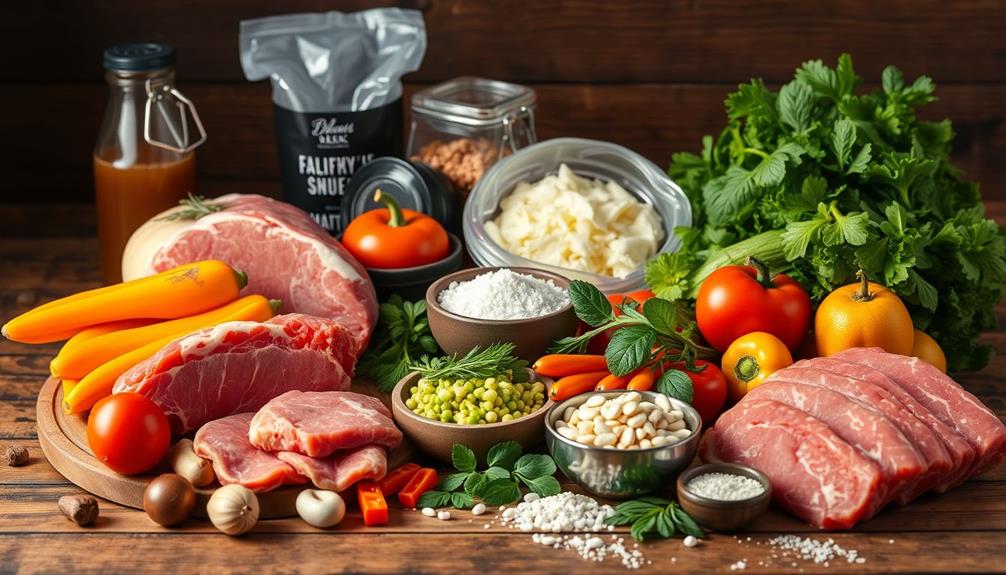
Choosing the right raw food for your puppy can greatly impact their growth and health. When selecting a balanced raw puppy food, prioritize high-quality, fresh ingredients that promote easier digestion and ideal nutrient absorption.
It's important to take into account the benefits of essential oils for overall wellness, as essential oils for respiratory health can support your puppy's immune system alongside a nutritious diet. This is essential for developing puppies who require a complete diet to support their rapid growth.
Make sure the food contains essential proteins, fats, vitamins, and minerals tailored to their specific needs. It's also important to check the calcium to phosphorus ratio; this balance is critical for healthy bone development and overall skeletal health.
Opt for commercially balanced raw food options from reputable brands that source their ingredients locally. This way, you can guarantee your puppy's food is free from antibiotics, hormones, and artificial additives, maximizing safety and quality.
Frequently Asked Questions
How Much Raw Food Should I Give My Puppy?
You should feed your puppy about 5-10% of their body weight in raw food daily. Younger pups might need closer to 10%, so adjust based on their growth and consult your vet for specifics.
How to Calculate How Much Raw Food to Feed a Dog?
Did you know that puppies should be fed about 5-10% of their body weight daily? To calculate their raw food needs, multiply their weight by the appropriate percentage, adjusting as they grow and become more active.
How Much to Feed a Puppy Calculator?
A puppy food calculator helps you determine the right amount to feed based on your pup's weight and age. Regularly input their data to adjust portions for ideal growth and health. You'll see progress!
How Much Do I Feed My Puppy Chart?
You'll find a feeding chart helpful for determining the right amount for your puppy. It considers age and weight, ensuring they get the nutrition they need. Always adjust based on their growth and activity levels.
Conclusion
So, you thought feeding your puppy raw food would be a piece of cake? Well, it's a bit more complex than tossing them a steak! By understanding their nutritional needs, calculating the right portions, and choosing quality ingredients, you're setting them up for a healthy future. Remember, it's not just about what you feed them, but how you feed them. Who knew puppy parenting could be this much fun? Get ready for some serious mealtime adventures!
Rachael, the Editor in Chief of RachaelsRawFood.com, is an inspiring and passionate individual who has dedicated her life to promoting the benefits of a raw food lifestyle. Known for her vibrant and energetic personality, Rachael has built a strong online presence that has transformed her personal journey into a thriving community of raw food enthusiasts.
-

 Raw Food Recipes2 months ago
Raw Food Recipes2 months agoHow Much Raw Food to Feed a Cat: A Simple Calculator
-
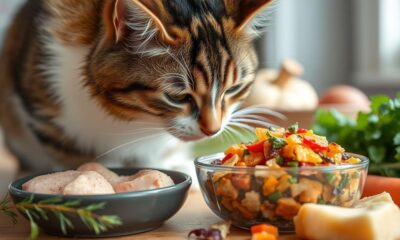
 Raw Food Recipes2 months ago
Raw Food Recipes2 months agoIs Freeze-Dried Raw Food Good for Cats? Find Out Here
-
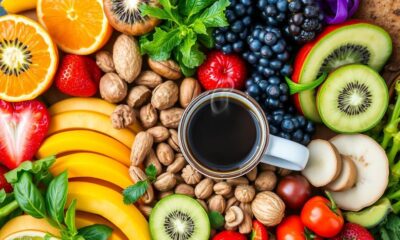
 Health and Wellness2 months ago
Health and Wellness2 months agoCan You Drink Coffee on a Raw Food Diet? What You Need to Know
-

 Raw Food Recipes1 month ago
Raw Food Recipes1 month agoHow Much Raw Food to Feed a Kitten: A Complete Guide
-

 Raw Food Recipes1 month ago
Raw Food Recipes1 month agoHow Much Raw Food to Feed a Puppy: Essential Guidelines
-
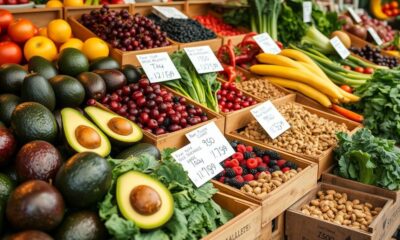
 Raw Food Recipes2 months ago
Raw Food Recipes2 months agoHow Much Does a Raw Food Diet Cost for Humans?
-

 Kitchen Essentials for Raw Food Preparation4 weeks ago
Kitchen Essentials for Raw Food Preparation4 weeks agoUnderstanding Ph in Raw Food Safety
-

 Raw Food Recipes2 months ago
Raw Food Recipes2 months agoDry Food Vs. Raw Food for Dogs: Which Is Better?


















